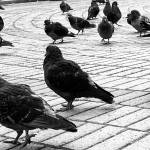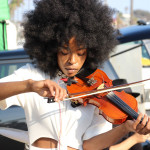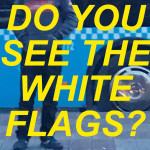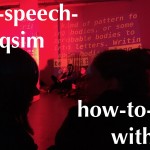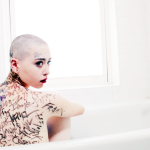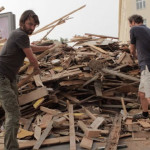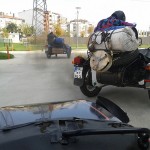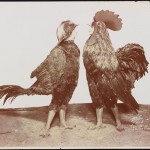Performance
Marlene KadgienThomas Geiger studied Fine Arts in Karlsruhe and Interdisciplinary Art in Tallinn, Estonia and is now settled in Vienna as a performance, sculpture and language artist with a focus on public space.
He is currently in Istanbul for a 3-month stay as part of the International Residency Program of the Austrian Cultural Ministry accompanied by the Austrian Cultural Forum Istanbul and Diyalog.
Co-financed by the Goethe-Institut, he was invited to the “Arter” Museum, one of the most renowned art houses in Istanbul, to present his performance “The Pigeon“, adapted to Turkish public space.
However, under the current conditions, triggered by the terrible earthquake in southern Turkey, Kurdistan and northern Syria, the performance has been cancelled until further notice.
Geiger plans to realise the performance in another house or place in a respectful way towards the earthquake.
In his performance “Le Pigeon” (The Pigeon), first realised in Paris, Thomas Geiger shifts the perspective of the recipient and focuses on the omnipresent pigeon in public space. In doing so, he gives a voice to the expert for this space, as Geiger calls the pigeon, in order to draw attention to its living space, which is threatened by privatisation.
In the continuing version in Istanbul the pigeon is to remain the protagonist as a recurring character, sharply criticising and questioning the advancing privatisation, which is often only distinguished from private space by only fences or walls.
In this way, he places objects of everyday life and daily perception in a slightly shifted context and encourages the recipient to rethink the prevailing structures.
In his new project “Istanbul Simit Exchange”, Thomas Geiger plans to buy a vendor’s daily supply of simits and offer them to pedestrians for free. In return, he invites them to draw their own simit on a sheet of paper as a value compensation. As is well known, the steadily decreasing purchasing power of the Turkish lira can be illustrated by the price of simits and underlines the ever-shrinking, affluent middle class and ever-increasing poverty in Turkey. The basic idea of the project is to take up and critically question the issue of value representation and the payment for creative work. So you don’t pay for your simit with money, but with a small, creative, self-produced piece of work. These creative imitations of the simits will then be sold in Vienna as components of his project “I want to become a millionaire”, which has been running since 2010.
The performance was canceled because of the earthquake that took place Feb 6 in Turkey and Syria. Instead the artist will prepare a video of the performance which will be screened later on. Watch out for further notification. [...]
Read more...
Julie PetersEven if world wide’s biggest museums have opened online platforms for virtual visits of their collections and audiovisual platforms have developed special programs for this confinement period, we feel disconnected from live experiences and social confrontation with art and culture.
While thinking about some connections between the actual world situation due to COVID-19 and the limited access to art and culture, we got inspired by some people and projects:
Sudan Archives and her “Black Renaissance”
In an interview with Titel Thesen Temperamente this violist and vocalist Sudan Archives gives to see an impressive and inspiration character, ready to get rid of any kind of barriers in a musical but also societal way. As a woman with her own roots, she questions her background and the actual debates around it using a style that mixes traditional African music with soul, R&B and also electronic sounds, all together with her violin she self-taught herself.
Brittney Parks, the 25-year-old artist who records as Sudan Archives, speaks the way her music sounds — meandering passages that flutter and unravel, threading darkness and humor, creating novel avenues to fundamental truths.
Sudan Archives released her debut Athena last November, the album cover featuring Parks as a statue. She wanted to model herself after Athena, the Greek goddess of wisdom and war, aiming to replace the typical white bodies she would see in museums. “I knew I wanted to be a sculpture. I was traveling so much, seeing all these sculptures of white people. That led me to research all these goddesses. I just thought it would be cool if you google ‘Athena’ and you see me.”
Let’s take her as a lesson and enjoy this unusual time to teach ourselves an instrument we’ve always wanted to play or left aside… she creates – as she mentioned – an entirely new story in the places in between where no one else has explored.
Glorious from the Album Athena
Another example is the Turkish artist MK Yurttaş:
Performistanbul – “In return”
The discovery of the project “In return” by the artist Mustafa Kemal Yurttaş (MK Yurttaş) has been like an echo to the issues we have started to deal with recently: how can art be taken out of traditional spaces like galleries, museums etc. in order to be accessible in times of crisis? And beyond this argument, how is solidarity implemented in times of a virus and how do trades (as services or goods) take place between the people in a period where no one knows exactly about the future?
From 01.02.2020 to 01.06.2020, the artist proposes to come into people’s houses and break the boundaries with accessing the arts by thinking about the opacities between the artist, the audience and the spaces/institutions.
He wants to come to your place, cook for you and he wonders what will you do in return.
Let’s live this experience by inviting him through this link: http://performistanbul.org/index.php/inreturn/ [...]
Read more...
Thomas BüschLecture Performée Nawar Bulbul / Marcos Aila Forero from Le Grand Café on Vimeo.
By Fares al Zahaby
Directed/Performed by Nawar Bulbul
at Lale Kod in Istanbul September 8/9
Mawlana, written by Fares al Zahaby and performed live by Nawar Bulbul, tells the story of a young man who grew up underneath a conservative Sunni father. Disenchanted with the dogmatism in his life, the young man seeks spiritual renewal through Sufism only to discover that it too refuses to see validity in any religious belief outside itself. This play is about one man’s struggle to break from tradition in an increasingly sectarian world.
Saturday September 8 and Sunday 9 at 8 pm
Lale Kod
Seyitnizam Mahallesi, Mevlana Caddesi & Kiptaş 92/1G
Zeytinburnu 34015, Istanbul [...]
Read more...
Sabine KüperThe Performance „Dal non-finito al finito“ was shown on the 1. Arts- and Culture-Festival of the Culture-Academy Tarabya (30.06.18) as a Premiere. Nezaket Ekici is alumnus of the Academy.
Interview with the artist:
In which frame do you use the title?
In my performance “Dal non-finito al finito” I follow in the footsteps of the sculpture. The term “non-finito” is a fixed term in art history. It was already used by Michelangelo and used by August Rodin as a fixed stylistic device. For financial reasons, Michelangelo made unfinished sculptures. August Rodin, on the other hand, consciously used the unfinished nature of the sculptures to evoke emotions in the viewer.
This is how I model myself from the clay mass. More and more fragments of my body parts appear. It partly looks like the figures of Rodin. But I sculpt more and more until I free myself from the clay completely. I become a living sculpture.
I was also inspired by the image of the ancient god Atlas. Atlas was a Titan and son of Mother Gaia (Mother Earth). By carrying the world on his shoulders, he symbolizes the Atlas Mountains. Interesting is also that atlas in ancient Greek meaning carrying and indulgence.
It was wonderful to develop the performance with the help of artists like Çağla Sönmez Çakır, Özgün Kutlu Türer, Pelin Terzi and Ayşe Tanman. I want to thank them so much.
A Lady was spontaneously referring to someone freeing himself from debris during you’re performance. Does this make sense to you?
You could also see this interpretation in the performance. Get rid of the rubble from the grave. Everyone sees something different in the performance. That is something positive. The aim of the performance is to awaken associations in the audience.
3. How does the performance correspond to the location and how does it relate to your current artistic phase?
The place is of particular importance to me because I lived and worked here for 10 months. The Culture Academy could be seen through its garden and forest as a large sculpture park.I coreographed my performance specifically outdoor, on the lawn, near the forest, completed with the image of the dense trees. Like a garden sculpture, which should enter into an aesthetic composition with the environment.Lately I do more sculptural performances. Since I once studied sculpture, besides painting and performance. I go back to the origins of my sculptural work.I have already done some work with materials such as clay, earth and plaster. Last eg. Pondus (2015) in which I box a 1-ton clay block. I am fascinated by this material. Besides, I work a lot on freedom. An eruption of sound and the free choice of the Atlas to carry the world and endure its weight, that probably describes my current phase quite well.
[...]
Read more...
Thomas BüschThe artist in residence from Austria – Maurizio Cirillo – will have a performance at Aksaray, Istanbul on Saturday February 23, 2018 between 11 am and 6 pm. Maurizio Cirillo lives and works since December in Istanbul. Maurizio Cirillo’s artistic practice, consisting of objects, photographs, videos, drawings and prints, could be seen as an on-going research on everyday life.
Performance by Maurizio Cirillo: Staying on the Platía Omonías in Athens for five days at a previously determined time span. 2013
The feeling of defencelessness and helplessness to the point of unconsciousness. We want to understand, to comprehend and fail miserably. In his work „Aksaray. Do you see the white flags?“ he wants to trace these feelings. Seemingly without plan, he will spend time on the square. he simply stand there, sunk in himself. In his presence, I is absent. He will show nothing, nothing concrete at least, only his physical presence. He surrenders himself, so to speak, to the urban space. He will take his place on the big square next to Aksaray Metro İstasyonu just come by and join him to experience the square!
His fellowship in Istanbul is part of the program of the Federal Chancellery of Austria. The Federal Chancellery of Austria awards four grants per year to Austrian artists in the framework of an abroad studio program. The artists use the time in Istanbul to realize projects in an international context, gain new inspiration and extend their networks.The cultural initiative diyalog, as the program’s partner, introduces the awardees to the arts scene. Through its network it offers them the opportunity to examine current artistic trends and exchange ideas with other artists and curators.
With a support of
[...]
Read more...
Thomas Büsch
Interactive Performance, 60 min. by Alexander Tuchacek
GaleriBu, Istanbul – January 10, 8 pm
The current artist-in-residence in Istanbul from the City of Zurich – Alexander Tuchacek – works with sound, natural language, voices, computer codes and text. The Austrian born artist lives in Zurich and has a professorship at the University of the Arts Zurich.
Since the early nineties he has developed data spaces in which visitors can rearrange abstract visual and audio structures. For him promises of self-empowerment and participation are integral to his performances and installations.
For Istanbul he is preparing the interactive performance how-to-do-speech-with-taqsim based on the interdiction of speech and language which we are experiencing recently world wide in the polarization of communities, prejudices, origin, ideologies and ethics. The audience will be involved and becoming part into this performance by using their mobile phones by doing so they are becoming an active part of the networked presentation.
For how-to-do-speech-with-taqsim he uses “taqsim” as a form of musical improvisation, that usually precedes the performance of a traditional Arabic, Greek, Middle Eastern, or Turkish musical composition. He will therefore perform a software code, which consists of parts of a text concerning the topic of how to speek (in a political sense) in digital networked enviroments. During the performance, he will stretch, loop and distort text fragments based on activities of European right-wing populists, protests of activists and passages from a popular Turkish music. Within the performance the spectators are required to intervene into the given sound installation by using their mobile phones and become part of the mediated ephemeral space, a sort of becoming a collective voice but through their digital devices. This interactive performance requires a contemplative thinking space in which comfortable seating (e.g.on the floor) for the audience is required.
Since 2015 the City of Zurich awards an artist-in-residence grant for Istanbul in the frame of its cultural promotion program. The selected artists are working and living in Istanbul for 6 month.
The residency program is supported and supervised by the Istanbul based cultural initiative diyalog. The intention of the granted stay in Istanbul is to provide the artists with a stimulating, enriching experience. Alexander Tuchacek is the fifth artist-in-residence of this program and he will stay in Istanbul until the end of January 2018.
GaleriBu
Serdar-ı Ekrem Sok. No:11
Galata / Beyoğlu / İstanbul
supported by
[...]
Read more...
Sabine Küper
TomTom Mahallesi in Istanbul is a quarter inhabited by local craftsman, garbage collectors and street sellers as well as hosting fancy designer shops and emerging art spaces. In former days it was the center of the Italian Levant including the historical Hotel Italya. Today the Consulate General of Italy remains beside lots of abandoned historical buildings. MAstudio is the working space of French-Turkish artist Mathilde Melek An. In that area it is a unique example regarding the implementation of artistic practice to the atmosphere and architecture of the urban environment.
MAstudio is located in a historical building that has always served as a location for local craftsman to produce and offer their goods in one tiny space. Small smart practical and tasteful interventions by artist Mathilde Melek An have transformed the narrow three floor roof terraced building to a functional studio and exhibition space in the past year. The artist is using fusions of materials, topics and spaces in all her artistic productions and presentations. The current show is part of “Open Performance Space”, a series of Performance events curated by Pınar Derin Gençer. Last summer Mathilde Melek An produced the performance Video “Golddess” in Cappadocia, an area full of caves and rock formations shaped by a vivid history and a rough environment.
MAstudio. Goddess calling from InEnArt on Vimeo.
The artist is performing in a golden armor with a headdress fusing forms of masks, crowns and helmets. Azure blue pigment powder on her skin is completing the orchestration of the birth of a goddess popping out of the blue to conquer a timeless unknown world full of secrets and oddities. The title “Golddess” is creating some of the humorous but well designed double layers within Mathilde Melek An’s works. The satirical touch implies all kind of serious abysses and ambiguities. The location is partly reminding Pasolini’s set up in the late 1960th orchestrating Medea at destinations like Aleppo in Syria, Göreme/Cappadocia and on a shore with the occasional appearance of an industrial tanker in the background of the scenery of the historical ancient play. An’s dress and performing style could be part of a current Music Video of the Formation “Empire of the Sun” famous for their elaborate stage sets and headdress, which reflects the duo’s background in visual art.
Mathilde Melek An is working on topics like gender and identity by using her multicultural background and playing with certain visual icons and patterns. Dressing in a shiny robe and posing as a blue angel on the set up of a poster bed with the face expression of a sphinx is dissolved in shots of a blue robed woman sinking in a swimming pool. The serial “blue angel” is quoting the movie that transformed Marlene Dietrich into an icon and is dissolving this in the production of several archetypical visuals orchestrated like film sets. The display of female poses is shifting between romantic motives and pop art esthetics leaving space for an internal discussion of the construction of femininity, gender roles and cultural differences. Or in the artist’s own words:
“In a continual voyage between the waters of occidental and oriental, I question cultural, sexual, and geographical identities, our memory which is both individual and collective, in an effort to bind our personal relationships to legacy’s transmission through generations.”
Mathilde Melek An is combining personal and anonymous photographs to create a fictional archive of the reconstruction of memory. Reenactments of herself in the historical set up of famous Turkish lifestyle magazines for example is merging times and the experiences of herself in comparison to her female relatives, who grew up in the Turkey of the 1950th and 1960th, when the magazines were reflecting the fashion and role models of the Turkish urban society.
Refreshingly these constructions are avoiding any kind of evaluations or preferences. The mixture of topics and motives create an impressive body of visualized contextualizations creating new forms and commentaries. In the series M.M. the artist is reenacting the esthetics of certain iconic pictures of the film star Marilyn Monroe. Wearing a blond wig and imitating the poses of the orchestration of a babyfaced sex bomb the performance reveals images that echoe and mirror archetypes of experiences by renaming and recontextualizing them. Like in the works of American artist Cindy Sherman the focus is not the individual motive but the orchestrated function and the archetypical radiation of the artwork.
Mathilde Melek An is connecting the more flexible and moving elements of performance, filming and photography with rigid objects out of ceramics, wood or resin. A series of ceramic legs are covered with colored glaze and drawings. They seem to be decorated with invisible shining stockings and calligraphic Tattoos. In fact they are carrying some of the themes implied in the moving, animated works of the artist. Appealing as attractive objects of femininity the tiny sizes of the sexy ceramic legs are transporting the uncomfortable subtext of a pedophile layer of content and for the glimpse of a thought adding a malicious texture to the beauty of the objects.
[...]
Read more...
Thomas BüschIf anyone is going to be threatened by a small penis, it’s Trump
The artist’s pencil drawing by feminist artist Illma Gore desplays the nude Donald Trump. The uploading of her artwork to a private Facebook group has resulted in what appears to be an indefinite ban from Facebook.
In a pastel painting called “Make America Great Again” Donald Trump the Republican presidential contender is shown stark naked, sporting only a gold chain. The painting has now gone viral, and furious Trump supporters are inundating the artist with online threats and abuse.
Gore allows Web surfers to download the portrait for free on her website, and also offering a censored version that has already appeared on some news sites.
Since then, Facebook has been periodically blocking her from accessing her profile as those of you who have shared it, although the work still remains on the page.
At 12pm on 29 April, the artist left her house to go to the art store. Had she known about the protests happening nearby, she probably would have stayed home. As she walked along Alivira Street, a car full of young people pulled up beside her, yelling slurs at her as she walked by. The only thing she heard clearly was “TRUMP 2016!”
As she approached the stopped car without looking away from her phone, she heard the passenger-side door open. She looked up, and a slender man got out of the car and punched her in the face as the group began to laugh and cheer the action on.
“TRUMP 2016!” he yelled.
She didn’t fall from the impact of the hit, but she stepped back to catch herself, and in doing so, tripped over on to the grass and watched her phone skid across the pavement. It happened so quickly the man had already fled, laughing, with his friends as she hit the ground.
The Los Angeles-based artist’s work is based around political topics and the physical self, the significance and importance we place on our bodies. She don’t think one should be emasculated by their penis size. The genitals shouldn’t define the power, or the status, or the gender.
One of her most famous works was a 2015 project, “Tattoo Me,” in which she tattooed her body with names crowdsourced from the Kickstarter and GoFundMe websites for $10. “It’s about striving to give oneself to others on a canvas that breathes, a canvas that can’t be sold in a gallery,” she told The Guardian last year. From Kickstarter Gore got kicked off with no explanation.
Gore speaks sincerely about the importance of her piece’s permanence: “It’s about striving to give oneself to others on a canvas that breathes, a canvas that can’t be sold in a gallery. That’s what interests me. Tattoo Me is about exercising ultimate individualism, while handing oneself over to the whims of the world we live in.”
As she fends off Trump trolls online, Gore says her latest artwork has the same message as her previous work. Gore, naturally, is frustrated by the entire situation and the ban from facebook and the seemingly arbitrary way websites react to different images.
“Who decides this hierarchy of ‘fine art?’” Gore said. “And why is this value judgement being placed on artworks for sale in an online market place or social media ? More importantly, why other than an attempt to try an censor the image, should eBay or Facebook ever prevent me or any other contemporary artist from selling or posting their work?”
Read more about it at Hyperallergic [...]
Read more...
Thomas BüschAustrian Artist Manfred Grübl in Istanbul
Screening of One Day Home, May 21st 7 pm at Studio-X Istanbul
Getting in Touch
Manfred Grübl is the recent artist in residence in Istanbul by the Austrian Cultural Program backed by Austrian Federal Chancellery. He lives and works for three month in Istanbul since March 2015.
We visit him in his Istanbul studio:
An outstanding modern building in Cihangir, Firuzağa Mahalle. The doorman asks about the purpose of your visit and nodds understandingly when you query where to find „the Avusturyalı“. „The Austrian“ is Manfred Grübl, artist from Vienna, who is currently living and working in Istanbul as a stipendiary organised and backed by the Austrian Federal Chancellery, Arts Section.
He lives in the studio together with his wife and his daughter, whereas the dog had to stay in Austria: „Actually, it’s a Turkish dog! I bought it here 12 years ago on a bazaar“ he tells. The place is light and bright, it speaks of family life, of being strangers in Istanbul and of Grübl’s artwork: His drawings are hanging on the wall right next to the ones of his daughter, alongside a city map and some detailled photos of a minaret.
„Actually I am drawing a lot here at the moment“, he states. „Drawing has often helped me to get started in foreign cities.“ In not more than 10 minutes each he depicts the loudspeakers shaping the appearance of the surrounding minarets, the Blue Mosque and images of upcoming art projects.
Manfred Grübl is a tall, bearded man around 50 and he is excited about the diversity Istanbul has to offer. He spent the morning taking pictures of residential areas on the Asian side of the Bosporus. Grübl has been studying architecture and sculpting and is preferentially developing installations in the last years. „This is an interesting field of work for me as it allows to combine different types of media“, he says. In the course of this credo he has had a barking conversation with his dog or positioned mute and stiff observers in an exhibition. Getting in interaction with the audience means a lot to him as one of his latest works shows: People are asked to send him a letter and will not only receive a reply in return but a card including an official Austrian stamp imaging himself.
One Day Home
Gecekondu in the centre of Istanbul
In Istanbul he is not only replying to letters and preparing projects he is going to realise when back in Austria. His interests are focused on urban development, the transformation of cities and basic rights.
On May 21st at 7 pm Studio-X Istanbul is screening the movie “One Day Home” by Manfred Grübl and Werner Schrödl. After the screening there will be an artist talk.
The movie One Day Home is an attempt to realize the dream of a self-built home. The main themes of the project are issues of autonomy and independence from large networks, the ability for self-organization, and the demand for rights, in particular fundamental rights that protect the people against the state. Fundamental rights are closely linked to the idea of human rights, which find their philosophical roots in the idea of natural rights, according to which there are „legal principles“ which are stronger than any law.
As an example of these fundamental rights, they wanted to identify the „gecekondus“, the Turkish term for an informal settlement or unplanned neighborhood with simple accommodation buildings.
According to this rule houses, which are built during one night on public grounds, cannot be demolished by the authorities, even though they are constructed illegally. Although not fixed in any law, this proceeding led to enormous expansions of Turkish cities, e.g. Istanbul, during the last decades as the quarters aroused like this were authorized by the state every some years.
The Presentation arranged by the InEnArt team will be followed by a discussion on the effects on urban developmet in Turkey an elsewhere.
After the screening there will be an artist talk.
„For me it is a question of basic rights: The right, to choose your place of living and the right to engross public spaces“, Grübl mentions. For „One Day Home“ he made use of his fundamental right and ordered 40 cubic meters of wood waste to a parking lot in Vienna, which is located in a very urban, busy area. During one day he and his colleague built a multifunctional wooden “Gecekondu”-house out of the material, according to their sketches and with the helping hands of passers-by. The next morning they moved their house on a lorry and brought it to the Attersee, a lake, about 250 kilometers away. „Werner Schrödl grew up in the neighborhood of this lake, which is now a very well-off area. We observed the selling of all the lakefront properties since the 1980’s and now wanted to create a contrast to this“, Grübl tells. They set their wooden house on barrels, transformed it into a boat and spent an entire day on the lake. „Like this, we claimed our right to live on this lake – which is basically a public space – as well.“
[...]
Read more...
Thomas Büsch
There is no other piece of clothing discussed as controversial as the headscarf. Maybe women’s trousers were considered in a similar problematic way in the 1920s. Or the shortening skirts during the 60s. There were questions of moral and appropriateness arising, but they never contained religious aspects. The headscarf on the contrary is always leading to extensive debates – tapping on fashion, religious feelings and questions of women’s rights all together.
As Abdullah Hamidaddin, author and commentator from Lebanon, writes in an articel recently published on Qantara, the headscarf has gone through different meanings: „It has been an expression of male dominance, an act of religious piety, a manifestation of female oppression, a limitation to a female’s power of seduction, an icon of cultural pride, a slogan of resistance to colonialism, imperialism and globalisation, an indicator of a worthy wife, an evasion of feminine competition, a marker of otherness and a discouragement to harassers.“ Due to this plurality Hamidaddin mentions that it is insufficient to talk about „the hijab“ but about „the hijabs“. But his key point is another one: the tradition of wearing veils has always been a female one.
“As if I was posing nude in Times Square.”
In a discussion among friends on sexual molestation Hamidaddin was of the opinion that this crime is – as most of sexual maledictions – to be seen as a „pathological expression of power“. Because of this character of the offence, wearing a headscarf would not protect the women of getting victimised, he argued. So for him, the hijab in a way symolises the „men’s power over women“. Which lead reversed to his tweet: „A world in which women rule, men shall wear the veil.”
To underline his point, Hamidaddin put on his daughter’s headscarf and posted the resulting picture on Twitter and Facebook. With doing so he wanted to remind of the powerful male dimension lying in this piece of clothing and intended to scratch on the sharp distinction of men and women. The reactions he received were plenty, but very diverse as well: „It was as if I was posing nude in Times Square“.
As multifaceted as the feedback in the social media towards a man in a hijab are the ways states deal with the question of veiling: While France banned the wearing of burkas in general, they are still allowed in Great Britain. After a more than 11 years lasting trial the highest German court decided two weeks ago that teachers must be allowed to wear headscarves at school.
In Turkey, the issue might come up again the next Thursday, when the country is celebrating the Turkish Grand National Assembly’s first gathering 95 years ago. For one day public representatives are symbolically handing over power to children. Children teached by women, who were not allowed to wear a veil at work until recently. For the longest time the republic of Turkey has been sticking to the laical will of its founder, Mustafa Kemal Atatürk. He rejected the hijab as reactionary, un-Western and banned it from public institutions. Ruling AKP has been lifting this ban now and the country is still devided how to assess this: An act of liberation enabeling women to participate in public service displaying their way of life as AKP states? Or a strategy fostering the presence of religious elements in public, changing the whole country for the more conservative, as critics fear?
One who already brought this issue up in Turkey is Erdem Gündüz, later known for his silent resistance during the Gezi protests. „The standing man“ entered a university wearing a headscarf already in 2004 as a performance. So maybe now the time to get used to men wearing veils has truely come.
[...]
Read more...
Markus Schmidtleavinghomefunktion: 5 People + 5 Ural Motorcycles + 2 Years + 30.000 Kilometres
In September 2014 five young artists from Halle, Germany, started a two-years trip from Germany to New York City on the landway. – They are using old Russian Ural motorcycle going East to get to the West. They will cross 23 borders and will cover a distance of 30,000 kilometres. InEnArt met the five artists on their two-days stay in Istanbul.
Road of Fame
The journey is not a way to get a break of daily life; they intend to get new impulses and they want to exchang experiences with other cultures to overcome clichés and get connected to build up a community. It is their way to broaden their own horzions, get first-hand informations and questioning themselves “how do I handle the situation?”. Through these experiences they want to create a social project. The biggest challenge lies in advantage of rearranging one’s own preceptions of cultural and social space constructions.
That is why we decided to do this in two years to get a deeper insight, mentioned Elisabeth Oertel.
Johannes Fütsch, Sven Klatt and Lisa Müller, Elisabeth Oertel and Anne Knödler
They left their familar terrain entering an adventures of the unknown.
We use the motorcycles as a medium to get in contact with our social environment, said Anne Knödler.
They decided not to be a studio artist but expand their art practice into a mobile and intercultural art project.
Two wheels with sidecar
The Ural motorcycle is a cross-country vehicle which is also used and much appreciated in Georgia, Kazakhstan, Mongolia and Russia. This type of motorcycle with a sidecar is a traditional means of transportation in many places there. It is generally considered robust, anyone can repair it and when necessary they can provide us with spare parts, yet it is said that these machines break down from time to time.
The motorcycle makes the difference
We opted for these old Russian motorcycles since for us the journey itself is the main issue
Follow the Trip
By keeping us up-to-date they are documenting their trip via filming, photographing and writing and publishing it regular at leavinghomefunktion.
The next stop on the trip will be in a small village in Georgia where they are going to stay six-month isolated from the civilization.
[...]
Read more...
Thomas BüschBack in 1911, one of the most talked-about Broadway roles was played by a woman dressed as a rooster, and now you can revisit the surreal staging with recently digitized photographs from the Museum of the City of New York.
The Museum of the City of New York has taken on digitizing over 30,000 images of more than 5,000 Broadway shows from their theater production archives.
These selection of photos display a 1911 Broadway production of Chantecler. The show features only animal characters, centering on a rooster named Chantecler who believes his morning song brings the dawn. A pheasant in the forest attempts to win his love, but his heart ends up staying with the farm.
The show was wildly popular with the public, touring to 60 cities outside New York.
Compilation from Hyperallergic [...]
Read more...

